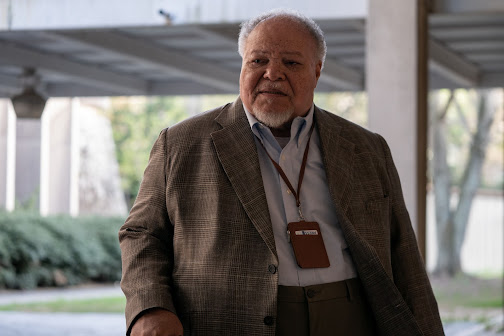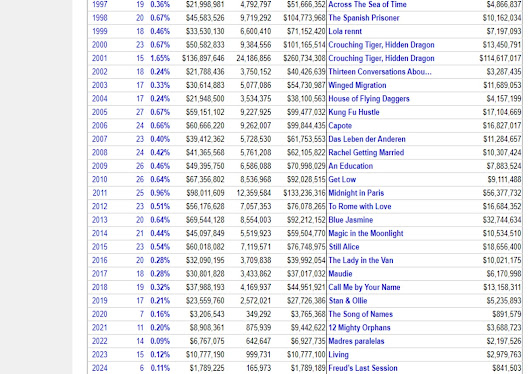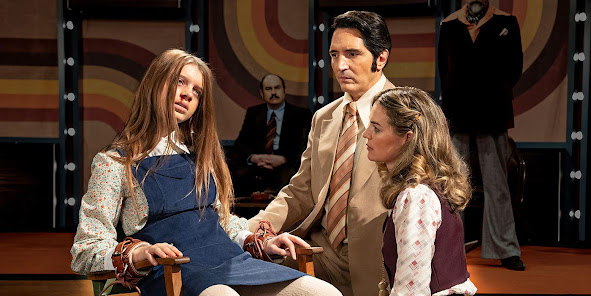I wasn't at CinemaCon 2024. My fellow Outside Scoop hosts Ryan Scott and Jeremy Fuster did attend the annual Las Vegas event (in which movie studios show off their upcoming features to movie theater owners)! I'm sure the next episode of The Outside Scoop will be chock full of amazing insights from the duo into what upcoming movies look especially choice. For now, though, I thought I'd divulge my thoughts on which studios brought the most buzz to CinemaCon. We're in a transitional period for theatrical cinema. Multiple major studios that have existed for decades are now on the selling block. The public personas executives and studio heads put on at CinemaCon (not to mention the kind of projects they announce) speak volumes about what the near future of cinema looks like.
Let's dive into that future by exploring what studios brought the goods, which ones stumbled, and which ones just registered as "meh" with their CinemaCon 2024 announcements.
Paramount Pictures Came Out Guns A-Blazing
Ten years ago, the 2014 Paramount Pictures CinemaCon panel focused almost exclusively on three movies: Transformers: Age of Extinction, Teenage Mutant Ninja Turtles (2014), and Hercules. It was a reflection of how few options the studio had in the mid-2010s with its DreamWorks Animation and Marvel Studios distribution deals firmly in the past. Cut to yesterday, though, and Paramount Pictures came out to theater owners with a slew of wildly varying movies headed to theaters. This included a new Damien Chazelle movie (Babylon stans rise up, we won!), a new Scary Movie sequel, an Edgar Wright Running Man remake, and the long-gestating musical comedy from Kendrick Lamar and the South Park guys. Oh, and there were also new Transformers and Ninja Turtles movies announced, because the more things change, the more they stay the same.
Paramount's explosive 2022 and scoring two major sleeper hits at the start of 2024 seems to have emboldened the studio to finally get a well-rounded slate of theatrical movies together. Heck, the studio even seems to have finally figured out its animated movie problem. For years, Paramount struggled to get a steady stream of new animated movies released. At CinemaCon 2024, though Paramount showed off six different theatrical animated movies destined for theaters over the next 30 months. Little strange Paramount didn't finally announce when Rosemary's Baby prequel Apartment 7A is finally coming out, but otherwise, strong presentation from Paramount.
Disney And Amazon MGM Studios Kinda Jogged In Place
Disney is in the middle of a transition period for its movie studios. David Greenbaum is only a little over a month into taking over as the head of the studio's movie divisions. Inevitably, the future is a little murky for the Mouse House, so not much was announced at CinemaCon 2024. Still, it was amusing that the studio didn't bring much new to the event. The Mouse House mostly just showed off lengthy pieces of footage from summer 2024 tentpoles like Kingdom of the Planet of the Apes and Inside Out 2. No mention of Searchlight Pictures releases, as near as I could tell. A forgettable panel with no big announcements.
Amazon MGM Studios did a closed-door showcase to exhibitors on its ramped up theatrical slate and revealed that new Bart Layton and Luca Guadagnino movies were headed to theaters in 2025. That's all well and good, but I was stuck by Deadline noting that Amazon MGM Studios was planning to send only 11 movies to theaters through 2026. The studio said it planned to do more than 11, but c'mon, those numbers are still meager. Movie theaters need product. Amazon has more money than God. It can afford to send out digital prints and market new movies. A deluge of new Amazon Studios releases (like Holland, Michigan, You're Cordially Invited, The Accountant 2, and Unstoppable, to name a few) are in various stages of production for inevitable streaming premieres.
Amazon MGM Studios should be sending as many movies inhabiting as many genres as possible to the big screen. Not just action films and award-season contenders. Movie theater exhibitors and moviegoers shouldn't be thankful to corporations for crumbs when it comes to sending titles to theaters. I had a similar thought reading updates on the Warner Bros. CinemaCon panel this year. Some of its upcoming titles sound fun, but it's hard to ignore the Coyote vs. Acme in the room the whole time. How many of these forthcoming features will actually make it to the big screen? Will Zaslav chuck them in a wastebin to get himself a few extra pennies?
Amazon, WarnerDiscovery, and other companies jeopardized the big screen experience by shoveling everything to streaming. Now they want to come to CinemaCon as "heroes" because they'll send a Dwayne Johnson/Chris Evans Christmas movie to multiplexes? Forget that! You don't get to be the arsonist and the fireman. When Amazon MGM Studios announces a commitment to making 21 new theatrical movies a year like Warner Bros. did back in 2011 or the 17-18 new theatrical movies 20th Century Fox supplied up until 2018, then we'll talk. Currently, Amazon MGM Studios only has seven theatrical releases scheulded for 2023 (I'm being generous and counting the one-week IMAX release The Blue Angels). That's the same number MGM released in 2021 without Amazon money at its back. 2021 was also when movie theaters were largely closed for the first three months of the year. Congratulations for maintaining the status quo and calling it something new Amazon! That's the Silicon Valley way! We should be demanding more from the few companies that have (almost certainly illegally) assumed so much control over the film industry. Otherwise, you end up with the Warner Bros. Pictures and Amazon MGM Studios CinemaCon presentations, which treated baseline competency as some kind of miracle worth applauding.
What's Going On, Lionsgate?
Now that we've got that leftist anti-corporation ramble out of the way, let's look over at Lionsgate. The indie studio that's too big to be a Relativity Media but never large or steady enough to be one of Big Five, Lionsgate showed up to CinemaCon with promises of big franchises...kind of. More footage from the studios The Crow reboot was dropped along with a new release date of August 23rd. How ironic that this and Kraven the Hunter are now opening back to back to close out summer 2023. Lionsgate also announced a big partnership with Blumhouse Productions to remake a slew of Lionsgate horror movies starting with The Blair Witch Project. That sounds like a shady prospect and not just because the folks behind the original movie have allegedly failed to get properly compensated for their work on that feature. How many "classic" Lionsgate horror movies are there? Is Blumhouse about to reboot The Cabin in the Woods? Are we due for a Cabin Fever legacy sequel? A Bigger Midnight Meat Train? This whole enterprise sounds like a boondoggle in the making.
Nosferatu Sounds Awesome!!
The most exciting presentation at CinemaCon, as a distant spectator bimbo in Dallas, Texas, was easily the first footage from the new Robert Eggers movie, Nosferatu. This production (the latest remake of the classic F.W. Murnau movie) sounds like it could be something special, not to mention as visually evocative as the other features Eggers has helmed. I'll be counting down the minutes until I can bear witness to this Willem Dafoe/Eggers collaboration! This footage came out during the Universal Pictures/Focus Features presentation, which, of course, hinged heavily on more Wicked: Part One material. To say I'm dubious of this feature sustaining two full-length movies is an understatement. However, it keeps sounding like Universal has a massive hit in the making here.
Have You Seen These Movies?
Finally, let's look at what wasn't shown at CinemaCon: a bevy of movies shot between 2020 and 2022 that major studios have acquired and/or financed, yet still don't have release dates. It seems like the big studios were stockpiling these titles to help fill in the gaps left in the release schedule by the two big 2023 strikes. However, it's getting bizarre how little information is out there for some of these titles that have been sitting on shelves for years now. For instance, the Legendary Pictures release The Toxic Avenger premiered last September to solid reviews. One might think either Columbia Pictures or Warner Bros. (the two go-to studios for Legendary) would pick it up. Still no word on when this one will see the light of day beyond Fantastic Fest. The Anthony Ramos astronaut movie Distant, meanwhile, was shot back at the end of 2020 for Universal. Still no word on where it is.
The list goes on and on. The Sony/Blumhouse horror film They Listen (starring Katerine Waterston and John Cho) started filming in the final weeks of 2022. It hasn't received a new date after it got pushed from its Labor Day 2024 slot nine months ago. Sony/Screen Gems also has The Haunting in Wicker Park on a shelf somewhere, though amusingly that project now sounds like a Late Night With the Devil knock-off. Should've gotten it out sooner! Lionsgate still hasn't divulged its plans for either The Home or Freaky Tales. Meanwhile, Warner Bros. hasn't confirmed whether or not Max Original Movies The Parenting and Am I OK? (the latter of which they acquired back at Sundance 2022) are still going to streaming. On and on the list goes, including the Legendary Pictures release Brothers (shot in 2021), the aforementioned Apartment 7A, and the Dylan O'Brien/Eliza Scanlen thriller Caddo Lake (for Warner Bros./New Line Cinema). So many major titles from the big studios are just hanging in seemingly permanent limbo. Without any new info on their release status emerging from CinemaCon, it's hard to get too excited about the future of these outfits while all the gaps in the 2024 release schedule get even more irritating. They have the movies theaters need, they're just choosing not to release them.











